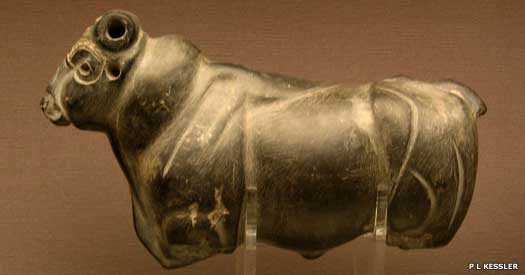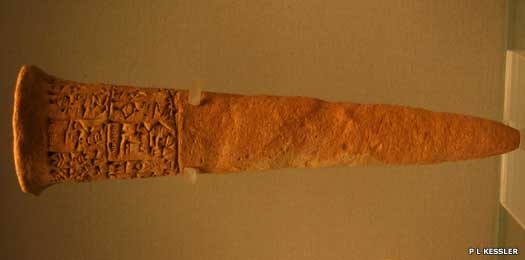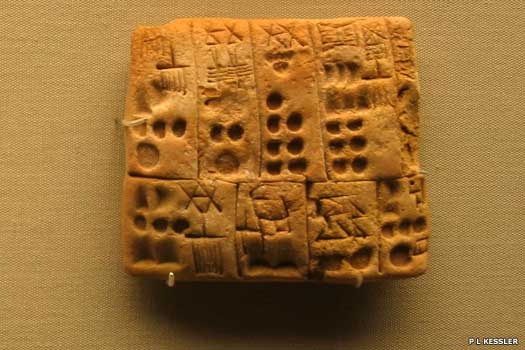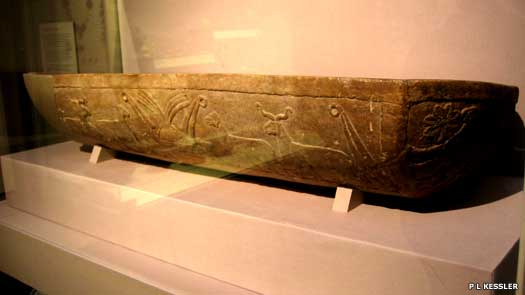
| CITY STATE OF URUK City State of Uruk / Erech / Unug / Urak (Eanna) :
The city of Uruk was situated to the east of the present course of the Euphrates, on the line of the ancient Nil Canal, in a region of marshes. It was one of the oldest and most important cities in Sumer. At Uruk, already a major city by 3300 BC, Sumerian civilisation seems to have reached its creative peak. Trade with many regions outside Mesopotamia was already flourishing by the start of the third millennium BC, notably with the Hatti in Anatolia.
The first documented king of Uruk founded his own dynasty in Eanna, which only became part of Uruk during his son's reign. Meskiaggasher won control of the region extending from the Mediterranean to the Zagros Mountains, east of Sumer, while Enmerkar officially gained the kingship after conquering Kish's First Dynasty.
FeatureAccording to the Sumerian king list, a total of 22 kings ruled for 2,610 + X years, six months and fifteen days, five times (dynasties) in Uruk. Here, List 1 is primarily used, backed up by List 2 and List 3 (see Sumer for details).
First
Dynasty :
Shortly after the end of the reign of Etana of Kish, Meskiaggasher founded a rival dynasty at Erech (Uruk), far to the south of Kish, which dominated Sumer. In this period, the city's rulers gradually grew in importance, and increasingly sought luxury materials to express their power. These goods, often from abroad, were acquired either by trade or conquest.
This is the second set of entries on the Sumerian list comprising kings 24-35. Twelve kings ruled for 2,310 / 3,588 years (Lists 1 & 2).
fl c.2750 BC :
Meskiaggasher / Mec-ki-aj-gacer : Of Eanna. Son of Utu. Ruled for 324/325 years.
The king list states that 'after kingship was brought to Eanna, Meskiaggasher, the son of the Sun God, Utu (Shamash), ruled as both en (priest or lord) and lugal (king) for 324 years during which time he entered the sea (the Mediterranean) and climbed the mountains (the Zagros Mountains)', ie. he created an empire.
Stone bull, Late Uruk Period, 3300-3000 BC, probably from Uruk fl c.2730 BC :
Enmerkar : Ruled for 420 years. Founded Uruk.
Enmerkar's reign is notable for an expedition against Aratta, a city state far to the north-east of Mesopotamia. He is succeeded by one of his military leaders. The exploits and conquests of Enmerkar and Lugalbanda form the subject of a cycle of epic tales constituting the most important source of information on early Sumerian history.
Lugalbanda : Ruled for 1,200 years. The 'Shepherd'.
c.2700 BC :
Following Lugalbanda's reign, domination of Sumer passes back to Kish, although the king list still has Uruk as possessor of the kingship.
Dumuzi / Dumuzid : Ruled for 100/110 years.
Dumuzi is 'the fisherman' who comes from the city of Kuara (Kua).
fl c.2650 BC :
Gilgamesh / Gilgamec : Ruled for 126 years.
Arguably the most famous of all Sumerian kings, according to the king list Gilgamesh is the son of a nomad. Traditionally, he is responsible for building the massive walls surrounding Uru and is recorded in the Epic of Gilgamesh.
Urnungal / Ur-Nungal : Son. Ruled for 30 years.
Udulkalamma / Udul-kalama : Ruled for 15 years.
Labasher / La-ba'cum : Ruled for 9 years.
Ennundaranna / En-nun-tarah-ana : Ruled for 8 years.
fl c.2600 BC :
Meshede / Mec-he : Ruled for 36 years. The 'Smith'.
Melamanna / Melem-ana / Til-kug : Ruled for 6/900 years.
Lugalkidul / Lugal-kitun : Ruled for 36/420 years.
c.2550 BC :
Then Uruk is defeated and the kingship taken to Ur.
fl c.2440 BC :
? / En-cakanca-ana / Enshakushanna : Ruled for 60 years.
Under Enshakushanna, Uruk conquers Hamazi, Agade, Kish, and Nippur to claim hegemony over all of Sumer. He also throws the Elamites out of Awan. He is the first ruler known to take the Sumerian title en ki-en-gi ki-uri, or 'lord of Sumer and Akkad'. Despite his own conquests he is briefly subject to Eannatum of Lagash.
Lugalure / Lugal-kinice-dudu : Ruled for 120 years.
c.2430 BC :
Uruk helps Lagash to defeat Umma.
A terracotta foundation peg of Entemena from Bad-tibira, dated between 2404-2375 BC, mentioning a treaty with the king of Uruk Argandea / Lugalkisalsi : Ruled for 7 years.
Uruk is defeated and the kingship is taken to Urim (Ur).
Third
Dynasty :
Under the priest-king Lugalzaggesi, Umma overthrew Lagash's domination, captured Uruk, displaced Kish as the dominating power, and claimed an empire which extended from the Mediterranean to the Persian Gulf.
This is the fourteenth entry on the Sumerian list comprising king 81. One king ruled for 25 / 34 years (Lists 1 & 2). Some lists combine the third and fourth dynasties as the third dynasty of Uruk, which also affects the numbering of the fifth dynasty.
c.2355 - 2330 BC :
Lugalzaggesi / Lugal-zage-si : King of Umma. Ruled for 25/34 years.
Lugalzaggesi of Umma is the last ethnically Sumerian ruler of Uruk. Around 2330 BC, he is defeated and captured by Sargon of Akkad. Sargon claims the empire and the kingship.
Fourth
Dynasty :
According to the the Sumerian list, the fourth dynasty of kings saw to the final defeat of Agade and claimed the kingship, or overlordship, of Sumer. In fact, it is possible that they were instead contemporaries of the later kings of Agade, holding some degree of dominance in southern Mesopotamia. The starting date of circa 2254 BC for this dynasty was calculated by counting back from the point at which the Gutians invaded Sumer and using the List 2 lengths of reign. It is perhaps only coincidental that this was the very same year at which it is thought Naram-Sin came to power in Agade, and who faced serious revolts from the start of his reign. Fourth Dynasty Uruk was a key player in those revolts, leading a coalition of southern Sumerian cities under Amar-girid.
This is the sixteenth set of entries on the list, comprising kings 93-97. Five kings ruled for 30 years (List 1), or five kings ruled for 30 / 43 / 26 years, or three kings ruled for 47 years (List 2).
fl c.2254? BC :
Amar-girid (?) : Vassal of Agade. Not on the king list.
c.2254? BC :
Uruk leads a revolt against the Akkadian empire, rallying the southern Sumerian cities of Ur, Lagash, Umma, Adab, Shuruppak, Isin, and Nippur, placing a well-organised army in the field which is then defeated.
c.2254? BC :
Urnigin / Ur-nijin : Ruled for 7/3/15/30 years.
Urgigir / Ur-gigir : Son. Ruled for 6/7/15 years.
Kudda / Kuda : Ruled for 6 years.
Puzur-ili : Ruled for 5/20 years.
Ur-Utu (or Lugal-melem) / Ur-babbar : Ruled for 6/25 years.
Fifth
Dynasty :
A surviving clay tablet containing the Sumerian king list was dated by the scribe who wrote it in the reign of King Utukhegal of Erech (Uruk), which places it at around 2125 BC. Uruk was responsible for driving out the Gutians. It was also prominent in the Sumerian struggles against the Elamites up to 2004 BC, during in which it suffered severely.
This is the eighteenth entry on the king list comprising king 119. One king ruled for seven years, six months, and fifteen days (List 1), or one king ruled for 427 years and an unknown number of days, or seven years, six months, and fifteen days, or seven years, six months, and five days (List 2), or one king ruled for 27 years (List 4).
c.2120 BC :
Utuhegal throws out the Gutians once and for all, claiming the kingship and becoming something of a hero figure to Sumerians. He also seems to govern Lagash for a time.
c.2120 - 2113 BC :
Utuhegal / Utu-hejal / Utukhegal : Ruled for 7 years, 6 mths, 15 days, or 427 years, or 27 years.
c.2112 BC :
The kingship passes to Ur.
An administrative tablet showing five commodities which to date have not been identified c.2004 BC :
With the collapse of Sumerian civilisation and the fall of Ur, Uruk is briefly occupied by invading Elamites before becoming a possession of Isin.
Amorite Rulers of Uruk :
The Amorites had been inhabitants of Sumer for some centuries, and rose to fill the gap left by the end of Sumerian civilisation. Uruk was controlled by Isin for approximately 133 years before that city state's decline allowed Uruk to break away under its own independent dynasty of kings.
Under Sin-Kashid, Uruk saw the renovation and reconstruction of the Temples of Ishtar/Inanna, which had fallen into disrepair in the previous century, and the building of one of the largest Old Babylonian Period palaces. It also appears to have become a centre of trade, as inscriptions giving the (ideal) prices of goods in the region show. The city became prosperous, although it apparently remained politically insignificant.
c.1865 BC :
Sin-Kashid, breaks free from the control of a declining Isin and founds his own dynasty in Uruk, which is the final period of independence for the city. He calls himself 'King of Uruk, king of the Amnanum', which is the name of his tribe of Amorites who had probably settled in the area during the Third Dynasty of Ur.
c.1865 - 1833 BC :
Sin-Kashid : Married daughter to king of Babylon and established close ties.
c.1833 - 1827 BC :
Siniribam : Son.
c.1827 - 1824 BC :
Singamil : Son.
Records become very sparse from this point under kings who seem to achieve very little.
c.1824 - ? BC :
Ilumgamil : Brother.
Eteja
Anam / Dingir-Am / Digiram
c.1816 - 1810 BC :
Irdanene : Son. Captured in battle.
c.1810 BC :
Rim-Sin of Larsa is aggressively expanding his empire, and following the fall of Isin, Uruk is a prime target. The city falls and becomes a vassal state, although still with its own kings who desperately struggle to assert their own authority.
c.1810 - ? BC :
Rimanum
? - 1803/2 BC :
Nabi'ilisu
c.1803/2 BC :
Rim-Sin of Larsa captures the city. It appears that Sinkashid's palace and the surrounding district are plundered and burned to the ground, after which time nothing is built in the area.
The Uruk trough belongs to the late prehistoric period, about 3300-3000 BC, but as it was probably a cult object in Inanna (Ishtar), it may have remained in use for quite some time c.1787 BC :
Still under the control of Larsa, Uruk is attacked and defeated by Hammurabi's Babylonian empire,
c.1763 BC :
With the defeat of Larsa by the Babylonian empire, Hammurabi controls Uruk.
Source :
https://www.historyfiles.co.uk/ |



